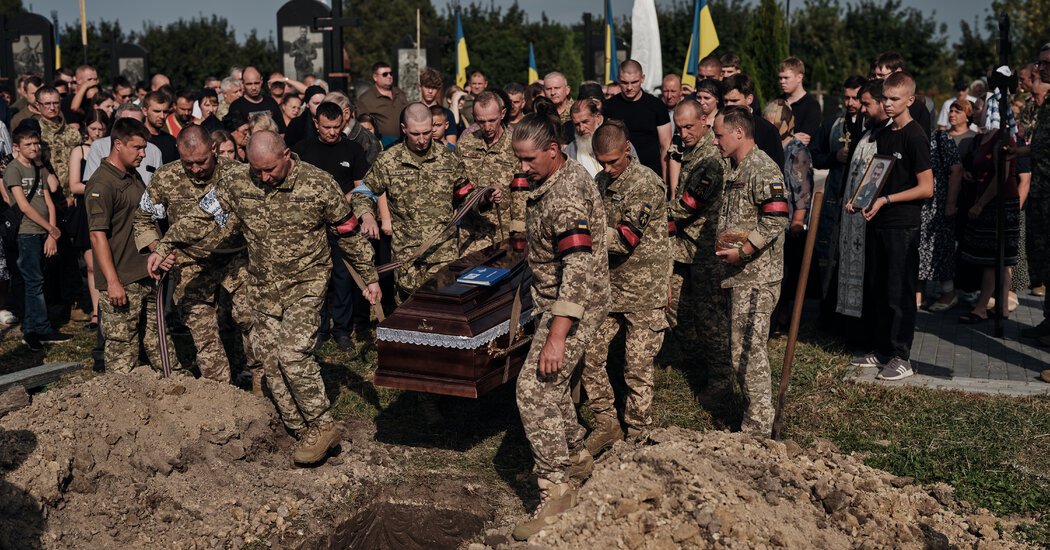
President Volodymyr Zelensky of Ukraine dismissed the head of the country’s Air Force on Friday, days after the crash of an F-16 warplane in what may have been a friendly fire incident.
A Western official who has been briefed on the preliminary investigation of the crash said that there were “indications” that friendly fire from a Patriot missile battery might have brought down the jet, though mechanical failure and pilot error have not been ruled out.
The dismissal of the Air Force commander, Lt. Gen. Mykola Oleschuk, announced by the president in a post on the Telegram social media app, is the second high-profile departure this year. In February, Mr. Zelensky dismissed Ukraine’s top military leader, Gen. Valery Zaluzhny, replacing him with Gen. Oleksandr Syrsky.
Mr. Zelensky gave no specific reason for the decision, which came one day after the Air Force had announced the loss of the F-16, but said that it was necessary to strengthen military leadership. “We need to get stronger,” he said. “And we need to take care of people. Take care of the personnel. Take care of all our soldiers.”
The plane crashed on Monday while defending against an intense aerial attack by Russian forces, which on Friday hit an apartment block in Ukraine’s second-largest city, Kharkiv, killing at least seven people and wounding scores more, local authorities said.
The possibility of friendly fire incidents becomes especially acute during mass attacks by missiles and drones, military experts say.
“Keeping track of what’s the good guy and what’s the bad guy particularly when there are missiles flying around at the same time is difficult,” said Mark Cancian, a senior adviser with the Center for Strategic and International Studies, a think tank based in Washington. “Fratricide is a huge problem.”
The United States has supplied Ukraine with Patriots, which include a powerful radar system and mobile launchers that fire missiles at incoming projectiles, and the Ukrainian military has used them frequently as part of its defense against Russian aerial attacks.
Ukraine took delivery of half a dozen F-16’s just a few weeks ago, the first of a total of 45 promised by its allies in Europe. The loss of one so soon after their arrival is a significant blow to Ukraine’s effort to integrate the aircraft into its war effort, and to convince NATO allies that it can efficiently handle sophisticated Western weapons.
The pilot of the plane, Lt. Col. Oleksiy Mes, died in the crash. He was one of only about a dozen Ukrainians who had been through an accelerated training program before going into battle, an element of added risk, experts said.
The United States and Ukraine are already collaborating on an investigation of the matter, and the American defense secretary, Lloyd J. Austin III, and Ukraine’s minister of defense, Rustem Umerov, held a scheduled meeting in Washington on Friday.
The aircraft, delivered after many months of pressure by Mr. Zelensky and other senior officials, are the most high-profile pieces of military hardware supplied by the country’s allies during the war.
As such, they have become a symbol of Ukraine’s defense and their pilots were considered by many people to be national heroes.
In a statement about the crash on Thursday, the Air Force said only that “communication was lost” with the plane, leaving unclear whether it had been shot down, by either enemy or friendly fire, or was a victim of mechanical failure, pilot error or another factor. The Air Force also said that F-16’s had shot down four Russian cruise missiles on Monday.
Military experts said that, while the loss of the aircraft is a setback, it is not unusual for fighter jets to crash, even in peacetime training missions, and that the impact on Ukraine’s overall war effort was likely to be small.
“Flying these things is a very high risk activity,” said Ben Barry, a senior fellow at the International Institute of Strategic Studies, a research institute in London.
Ukrainians have placed great faith in the potential battlefield impact of F-16s, which are better equipped for both defensive and offensive operations than the fleet of Soviet-era aircraft that Ukraine’s Air Force has been using. But experts have cautioned that it could take years before enough of the planes are delivered — and enough pilots and ground crews trained — for their full impact to be felt.
A recent report by the Center for Strategic and International Studies said that it should be possible for Ukraine to start to use the aircraft to hit ground targets soon, but it “will be years before the Ukrainian Air Force has enough experience to execute combat missions effectively.”
The nationwide missile and drone strike on Monday was one of the largest since the start of Russia’s full-scale invasion. Moscow followed up with another barrage on Tuesday and a smaller one on Thursday. In addition, Russia has also pummeled frontline areas in eastern Ukraine.
On Friday, a Russian glide bomb hit a mid-rise apartment block in Kharkiv, the head of the regional military administration, Oleh Syniehubov, said in a post on the Telegram social media app. Mr. Syniehubov said the strike would not have succeeded if Ukraine had adequate air defenses. He later said that seven people had been killed and nearly 60 others wounded.
Andrew E. Kramer contributed reporting from Kyiv, Ukraine.







